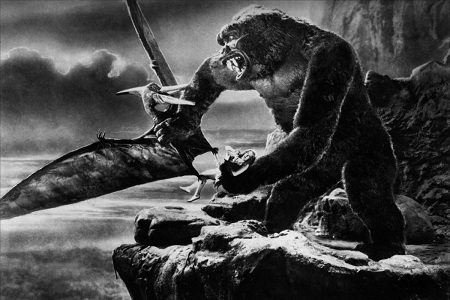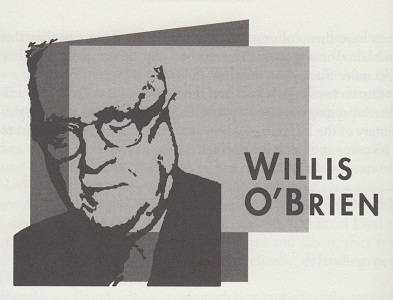Born: March 2, 1886, Oakland, CA
Died: November 8, 1962, Los Angeles, CA
O’Brien was a bloody genius, you know. He was the best trick man in the business. Nobody in his class.
—Merian C. Cooper
Willis O’Brien was a San Francisco cartoonist when the sculpting bug bit him in 1913. A year later, he began making small replicas of prehistoric creatures in his garage at night, molding rubber to a wooden figurine with moveable joints, then filming them moving against miniature sets. Working alone, O’Brien invented almost all of the commonly used practices of a process known as stop-motion animation—techniques that have remained relatively unchanged for eighty years.
After completing a number of shorts for Edison’s Biograph company, including his first film, The Ghost of Slumber Mountain (1918), O’Brien first used his innovative techniques in his animated sequences of several monstrous beasts in The Lost World (1925), a feature-length film starring Wallace Beery. The story involves an Amazon expedition’s encounter with a world of strange prehistoric beasts that battle with each other for survival. In the film’s climax, several of the dinosaurs escape captivity and terrorize the citizens of London. The two-hour film was all but destroyed in 1929, when an ambitious producer ventured to make a remake and burned all the existing prints to prevent unfavorable comparisons. Some 16mm copies surfaced later; trimmed in half so its running time coincided with the schedules and attention spans of young audiences, the film was shown in elementary schools. Those who have seen it are entranced by its thrilling re-creations of dinosaurs that come to life, and the concept has been duplicated endlessly ever since. Animator Bob Clampett cites The Lost World, particularly a scene in which a long-necked dinosaur swims under the ocean, as the inspiration for his sea serpent puppet in the popular 1950s Beany and Cecil TV show. Steven Spielberg recalls its startling jungle scenes as the inspiration for Jurassic Park (1993) and its sequel, which took the name of O’Brien’s seminal film.
By the 1930s, Hollywood had a bad case of jungle fever, setting dozens of features like Tarzan the Ape Man (1932) in the Dark Continent. Sparked by a trip to Africa, producer Merian Cooper sought to blend O’Brien’s striking effects with a good story. The final script became the most famous and influential special effects film ever made, one that coined the term “monster movie.” King Kong (1933) led Depression-era audiences to a mysterious place where ancient creatures fight savagely for survival and villagers live in fear of the beast called Kong—a name created to emulate the short, rough sound of the title of Cooper’s documentary Chang (1927). Originally Kong: The Eighth Wonder, the title was shortened to King Kong after scriptwriter Ruth Rose wrote the line “He was a king in the world he knew.”
To this day, King Kong is regarded as the masterwork in stop-motion technique. O’Brien’s ability to combine live-action seamlessly with animation created the illusion that New York City really was under attack. Meticulously scaling several models of the giant gorilla, O’Brien often labored on his own for months to create just seconds of screen magic.
Also important to O’Brien’s work was the mixing of live-action mechanical models with stop-motion animated footage. One particularly exhilarating shot in The Lost World features the large, intricate head of a brontosaurus poking into a window, an effect O’Brien created using a large armature attached to a crane. Close to the finale of Kong, the ape chases Fay Wray to a hotel in a scene that illustrates O’Brien’s attention to detail and sophisticated mix of live action and stop-motion animation. O’Brien, using two sets, one full-scale and one miniature, cuts between real car crashes, a miniature hotel marquee hurling through the air, fleeing pedestrians and, ultimately, a real marquee smashing into pieces; as the ape rips the sign from the building, faint clouds of dust add to the realism. This subtle mix of small models with large mechanical beasts is standard today; witness Jurassic Park.
Inspired by O’Brien’s animation in King Kong, a small army of young storytellers appeared, kids with home-made figurines and 16mm cameras. Legendary special effects man Phil Tippett, who gave life to the menacing AT-AT walkers in the ice fight of The Empire Strikes Back, and created life-like dinosaurs for Jurassic Park and its sequel, cites O’Brien as a mentor. Spielberg, George Lucas, Will Vinton and George Pal all received their first glimpse of their futures by watching O’Brien creatures at work. O’Brien gave his most famous disciple, the young animator Ray Harryhausen, his first shot at moviemaking with Mighty Joe Young (1949), another story about a giant ape, which scooped up the Academy Award for O’Brien. Harryhausen would later score big on his own with The 7th Voyage of Sinbad (1958) and carry the torch of stop-motion technique into a new generation of films, among them RoboCop (1987).
The movie monsters of Jaws (1975) and Alien (1979) owe their eyeteeth to O’Brien. His King Kong continues to tower above the classic fantasy films of all time. It has been shown on television more than any other film. Memorabilia is still in high demand—an original poster sold for $112,500 in 1994. To this day, Kong remains the Eighth Wonder of the World, and O’Brien stands alone as the pioneer of a unique film craft.
To read all the republished articles from ‘The Film 100,’ go to Reintroducing the Film 100 here on Keyframe.





